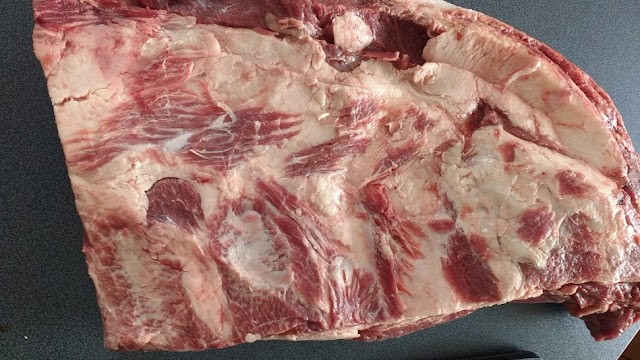We've barbecued a brisket years ago, not at all successfully. With our little Weber we weren't able to control the temperature and it ran too hot, too fast leaving dry, tough meat. Then we tried a hybrid approach, smoking the meat in the barbecue for flavour and finishing with a long slow cook in the oven. That worked very well, but it's been two years and we haven't repeated it.
But I think you've probably noticed that Paul takes his role as Chief Wielder of Fire and Knives quite seriously, and his ability to cook anything on a fire is one of the cornerstones of his identity. Without my even noticing, the brisket had become his white whale.
We ordered a whole packer cut brisket and he took a day off work (although the day off work was mostly planned because of the late finish of the Captain America marathon).
 |
| Whole brisket |
 |
| Brisket point |
 |
| Brisket flat |
Since Paul was so invested in his research, I figured I should probably be a useful and supportive partner and do a bit myself. Which consisted of opening Hog and reading the page on live-fire cooking. That gave the inspiration for moderating the heat with pans of water for the indirect cooking. Paul's been worshipping at the altar of Aaron Franklin, where he got the tip that keeping the humidity up is important, and the pans of water helped with that too.
 |
| Indirect cooking set-up |
A good bit of seasoning rubbed on the meat (although as it turned out, not enough and not massaged in enough) and away we went.
We'd realised that a really important part of moderating your temperature to keep it low and slow is to actually know what the temperature is. So a thermometer went in as well. And despite all the talk about hickory, pecan and mesquite, we decided that excellent British meat cooked in Britain needed a typically British smoking wood, so we used cherry.
Of course, being a British barbecue we also had to deal with some challenging climatic conditions. Pretty much as soon as we got the lid on the heavens opened, with rain and hail. Still, it was better than Tuesday, when it snowed. And one of the things that seldom gets mentioned when talking about barbecue is how much impact the ambient temperature has. We can and do barbecue in mid winter, but when it's really cold outside it'd hard to keep the temperature up for the fire to cook anything bigger than a steak. But when you want a long slow cook, a bit of colder air around the kettle isn't a bad thing, and helped us keep the fire between 120C - 150C for the duration of the cook.
After a few hours, when the internal temperature of the meat was 78C, just through the plateau, we wrapped it in foil and kept cooking for another couple of hours. Then it rested until we couldn't bear it any more.
 |
| Not bad |
 |
| Pretty good really |
It's actually a tribute to Paul's knife sharpening skills that he was able to cut it into tidy slices, because it was soft as jelly and could have been cut up with the side of a saucer.
 |
| Pretty pink smoke ring |
 |
| leftovers |
 |
| Brisket Stroganoff |





3 comments:
i believe we would be great friends if we didn't live on separate continents! i loved this post, not least because paul took a day off work to take care of some brisket business! :)
that looks absolutely delicious. So much care and thought paid off! The birds will enjoy the fat trimmings.
Grace - yes! I think we would be. Brisket business is serious business!
Mother - it was wonderful!
Post a Comment